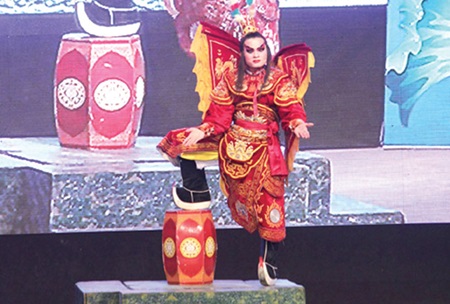Tuong actors mix it up for Tet
 |
| Bigger picture: A big screen reflection forms the backdrop as a tuong actor with Dao Tan Theatre performs. - VNS Photo Ngan Anh |
They will perform dozens of excerpts from famous plays like Ong Gia Cong Vo Di Xem Hoi (The Old Man Carries His Young Wife on His Back to Go to the Festival) and Ly Dao Thanh Xu An Thuong Duong (Ly Dao Thanh Passes Judgment on the Queen).
The performances are expected to be an amalgam of traditional and modern in line with the changing times, and will use modern sound and light effects on stage.
To attract people in HCM City, the Dao Tan actors will mix cai luong (reformed theatre) – a southern art form – with tuong.
"Like many of our peers in other traditional arts, we devote our energies to the stage, finding new ways to attract audiences, particularly youth," Nguyen Gia Thien, director of Dao Tan Theatre, said.
His theatre works hard to train younger performers, he said.
"Tuong should be passed on from older generations to younger ones in a series of processes, [which] leads to greater heights in creation."
Dao Tan Theatre staged a free performance at Sen Hong Theatre in District 1's 23/9 Park last week, an event that left a very strong impression on the audience.
The theatre plans to stage several shows in the city during Tet holidays, which begin on February 16.
Training problems
Around 2,000 people apply to the Ha Noi University of Theatre and Cinematography every year but no one wants to become a tuong actor, according to the Viet Nam Theatre Artists Association.
"We are facing a shortage of young and skilled performers," veteran tuong actor Le Chuc, a member of the association, lamented.
Cultural authorities need to invest in churning out talented, young performers if art form is to truly develop, he said.
Vietnamese classical drama originated in the 12th century, but took until the 17th to achieve strong development.
Along with other performing arts like cheo (traditional opera) in the north and cai luong, tuong is a vital component of the Vietnamese spirit and character.
Tuong developed from a folk art into a royal art. Its themes include loyalty to the monarch and patriotic duty – which define the play's structure, features, language, music, colour, struggles, and the personalities of the characters.
Performances consist of singing, dancing, and music that are highly stylised and filled with symbolism.
"In [other] arts like drama or cinema, amateurs can practise and perform a little bit, but you cannot do tuong if you have not been properly trained," Thien said.
Artists have to use their entire body, elbows and all. If they do not have a powerful voice, they cannot sing and dance at the same time or express the emotions of the characters.
Besides, they often have to wear costumes that are spectacular but weigh up to 10kg.
There are only seven professional tuong theatres in the country – one each in Ha Noi and HCM City and the provinces of Thanh Hoa, Hue, Da Nang, Binh Dinh, and Khanh Hoa.
What the stars mean:
★ Poor ★ ★ Promising ★★★ Good ★★★★ Very good ★★★★★ Exceptional
Latest News
More News
- Free tickets, Lunar New Year promotions on offer at Vietjet Mega Livestream (November 26, 2025 | 15:32)
- UNIQLO unveils upgraded heat-retention wear at Hanoi event (October 26, 2025 | 10:00)
- Vietnam named among world’s top four culinary destinations (October 24, 2025 | 17:09)
- Vietnam and Denmark strengthen dialogue on sustainable fashion (October 20, 2025 | 09:11)
- Fusion rolls out special initiatives to celebrate Vietnamese Women’s Day (October 17, 2025 | 20:00)
- Showcase AC 2025 set to light up Hanoi stage (September 12, 2025 | 18:06)
- Hotel Indigo Saigon The City hosts event to reimagine city’s beloved alleyways (July 23, 2025 | 17:04)
- UNIQLO’s sustainability strategy behind the brand's global growth (June 23, 2025 | 15:42)
- Vietnam International Travel Mart 2025 kicks-off in Hanoi (April 10, 2025 | 17:50)
- Phu Quoc named as one of Asia's 'Best Islands' (March 13, 2025 | 10:24)

















 Mobile Version
Mobile Version